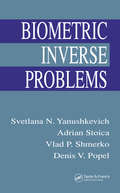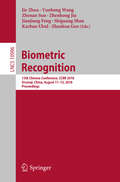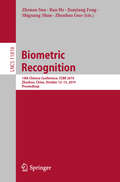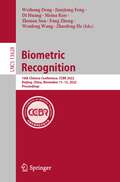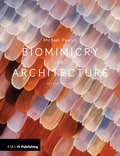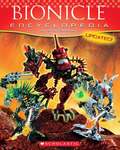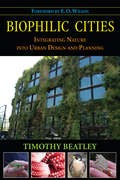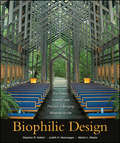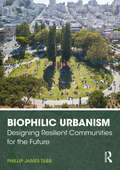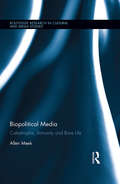- Table View
- List View
Biomedical Engineering Systems and Technologies: 13th International Joint Conference, BIOSTEC 2020, Valletta, Malta, February 24–26, 2020, Revised Selected Papers (Communications in Computer and Information Science #1400)
by Ana Fred Hugo Gamboa Federico Cabitza Elisabetta De Maria Xuesong Ye Filipe Soares Pedro Gómez VildaThis book constitutes extended and revised versions of the selected papers from the 13th International Joint Conference on Biomedical Engineering Systems and Technologies, BIOSTEC 2020, held in Valletta, Malta, in February 2020.The 29 revised and extended full papers presented were carefully reviewed and selected from a total of 363 submissions. The papers are organized in topical sections on biomedical electronics and devices; bioimaging; bioinformatics models, methods and algorithms; bio-inspired systems and signal processing; health informatic
Biomedical Engineering and Computational Intelligence: Proceedings of The World Thematic Conference—Biomedical Engineering and Computational Intelligence, BIOCOM 2018 (Lecture Notes in Computational Vision and Biomechanics #32)
by João Manuel R. S. Tavares Nilanjan Dey Amit JoshiThis book reports on timely research at the interface between biomedical engineering and intelligence technologies applied to biology and healthcare. It covers cutting-edge methods applied to biomechanics and robotics, EEG time series analysis, blood glucose prediction models, among others. It includes ten chapters, which were selected upon a rigorous peer-review process and presented at the 1st World Thematic Conference - Biomedical Engineering and Computational Intelligence, BIOCOM 2018, held in London, United Kingdom, during October 30–31, 2018.
Biomedical Image Registration: 8th International Workshop, WBIR 2018, Leiden, The Netherlands, June 28-29, 2018, Proceedings (Lecture Notes in Computer Science #10883)
by Stefan Klein Stanley Durrleman Stefan Sommer Marius StaringThis book constitutes the refereed proceedings of the 8th International Workshop on Biomedical Image Registration, WBIR 2018, held in Leiden, The Netherlands, in June 2018. The 11 full and poster papers included in this volume were carefully reviewed and selected from 17 submitted papers. The papers are organized in the following topical sections: Sliding Motion, Groupwise Registration, Acceleration, and Applications and Evaluation.
Biomedical Image Registration: 9th International Workshop, WBIR 2020, Portorož, Slovenia, December 1–2, 2020, Proceedings (Lecture Notes in Computer Science #12120)
by Orcun Goksel Žiga Špiclin Jamie McClelland Jan KybicThis book constitutes the refereed proceedings of the 9th International Workshop on Biomedical Image Registration, WBIR 2020, which was supposed to be held in Portorož, Slovenia, in June 2020. The conference was postponed until December 2020 due to the COVID-19 pandemic. The 16 full and poster papers included in this volume were carefully reviewed and selected from 22 submitted papers. The papers are organized in the following topical sections: Registration initialization and acceleration, interventional registration, landmark based registration, multi-channel registration, and sliding motion.
Biomedical Imaging and Computational Modeling in Biomechanics (Lecture Notes in Computational Vision and Biomechanics #4)
by Daniela Iacoviello Ugo AndreausThis book collects the state-of-art and new trends in image analysis and biomechanics. It covers a wide field of scientific and cultural topics, ranging from remodeling of bone tissue under the mechanical stimulus up to optimizing the performance of sports equipment, through the patient-specific modeling in orthopedics, microtomography and its application in oral and implant research, computational modeling in the field of hip prostheses, image based model development and analysis of the human knee joint, kinematics of the hip joint, micro-scale analysis of compositional and mechanical properties of dentin, automated techniques for cervical cell image analysis, and biomedical imaging and computational modeling in cardiovascular disease. The book will be of interest to researchers, Ph.D students, and graduate students with multidisciplinary interests related to image analysis and understanding, medical imaging, biomechanics, simulation and modeling, experimental analysis
Biomedical Signals Based Computer-Aided Diagnosis for Neurological Disorders
by M. Murugappan Rajamanickam YuvarajBiomedical signals provide unprecedented insight into abnormal or anomalous neurological conditions. The computer-aided diagnosis (CAD) system plays a key role in detecting neurological abnormalities and improving diagnosis and treatment consistency in medicine. This book covers different aspects of biomedical signals-based systems used in the automatic detection/identification of neurological disorders. Several biomedical signals are introduced and analyzed, including electroencephalogram (EEG), electrocardiogram (ECG), heart rate (HR), magnetoencephalogram (MEG), and electromyogram (EMG). It explains the role of the CAD system in processing biomedical signals and the application to neurological disorder diagnosis. The book provides the basics of biomedical signal processing, optimization methods, and machine learning/deep learning techniques used in designing CAD systems for neurological disorders.
Biometric Inverse Problems
by Svetlana N. Yanushkevich Vlad P. Shmerko Adrian Stoica Denis V. PopelTraditional methods of biometric analysis are unable to overcome the limitations of existing approaches, mainly due to the lack of standards for input data, privacy concerns involving use and storage of actual biometric data, and unacceptable accuracy. Exploring solutions to inverse problems in biometrics transcends such limits and allows rich analysis of biometric information and systems for improved performance and testing. Although some particular inverse problems appear in the literature, until now there has been no comprehensive reference for these problems. Biometric Inverse Problems provides the first comprehensive treatment of biometric data synthesis and modeling. This groundbreaking reference comprises eight self-contained chapters that cover the principles of biometric inverse problems; basics of data structure design; new automatic synthetic signature, fingerprint, and iris design; synthetic faces and DNA; and new tools for biometrics based on Voronoi diagrams. Based on the authors' vast experience in the field, the book authoritatively examines new approaches and methodologies in both direct and inverse biometrics, providing invaluable analytical and benchmarking tools. The authors include case studies, examples, and implementation codes for practical illustration of the methods. Loaded with approximately 200 figures, 60 problems, 50 MATLAB® code fragments, and 200 examples, Biometric Inverse Problems sets the standard for innovation and authority in biometric data synthesis, modeling, and analysis.
Biometric Recognition: 13th Chinese Conference, CCBR 2018, Urumqi, China, August 11-12, 2018, Proceedings (Lecture Notes in Computer Science #10996)
by Jie Zhou Zhenhua Guo Shiguang Shan Yunhong Wang Zhenan Sun Jianjiang Feng Zhenhong Jia Kurban UbulThe LNCS volume 10996 constitutes the proceedings of the 13th Chinese Conference on Biometric Recognition, held in Urumchi, China, in August 2018. The 79 full papers and 67 poster papers presented were carefully reviewed and selected from 112 submissions. The papers cover a wide range of topics such as Biometrics, Speech recognition, Activity recognition and understanding, Online handwriting recognition, System forensics, Multi-factor authentication, Graphical and visual passwords.
Biometric Recognition: 14th Chinese Conference, CCBR 2019, Zhuzhou, China, October 12–13, 2019, Proceedings (Lecture Notes in Computer Science #11818)
by Ran He Zhenhua Guo Shiguang Shan Zhenan Sun Jianjiang FengThe LNCS volume 11818 constitutes the proceedings of the 14th Chinese Conference on Biometric Recognition, held in Zhuzhou, China, in October 2019. The 56 papers presented in this book were carefully reviewed and selected from 74 submissions. The papers cover a wide range of topics such as face recognition and analysis; hand-based biometrics; eye-based biometrics; gesture, gait, and action; emerging biometrics; feature extraction and classification theory; and behavioral biometrics.
Biometric Recognition: 15th Chinese Conference, CCBR 2021, Shanghai, China, September 10–12, 2021, Proceedings (Lecture Notes in Computer Science #12878)
by Jianjiang Feng Junping Zhang Manhua Liu Yuchun FangThe LNCS volume 12878 constitutes the proceedings of the 15th Chinese Conference on Biometric Recognition, held in Shanghai, China, in September 2021.The 53 papers presented in this book were carefully reviewed and selected from 72 submissions. The papers cover a wide range of topics such as multi-modal biometrics and emerging biometrics; hand biometrics; facial biometrics; and speech biometrics.
Biometric Recognition: 16th Chinese Conference, CCBR 2022, Beijing, China, November 11–13, 2022, Proceedings (Lecture Notes in Computer Science #13628)
by Zhenan Sun Jianjiang Feng Wenfeng Wang Meina Kan Weihong Deng Di Huang Fang Zheng Zhaofeng HeThis book constitutes the proceedings of the 16th Chinese Conference on Biometric Recognition, CCBR 2022, which took place in Beijing, China, in November 2022.The 70 papers presented in this volume were carefully reviewed and selected from 115 submissions. The papers cover a wide range of topics such as Fingerprint, Palmprint and Vein Recognition; Face Detection, Recognition and Tracking; Gesture and Action Recognition; Affective Computing and Human-Computer Interface; Speaker and Speech Recognition; Gait, Iris and Other Biometrics; Multi-modal Biometric Recognition and Fusion; Quality Evaluation and Enhancement of Biometric Signals; Animal Biometrics; Trustworthy, Privacy and Personal Data Security; Medical and Other Applications.
Biometric Recognition: 17th Chinese Conference, CCBR 2023, Xuzhou, China, December 1–3, 2023, Proceedings (Lecture Notes in Computer Science #14463)
by Jun Wang Shiqi Yu Zhaofeng He Wei Jia Wenxiong Kang Zaiyu Pan Xianye Ben Zhengfu BianThis book constitutes the proceedings of the 17th Chinese Conference, CCBR 2023, held in Xuzhou, China, during December 1–3, 2023. The 41 full papers included in this volume were carefully reviewed and selected from 79 submissions. The volume is divided in topical sections named: Fingerprint, Palmprint and Vein Recognition; Face Detection, Recognition and Tracking; Affective Computing and Human-Computer Interface; Trustworthy, Privacy and Personal Data Security; Medical and Other Applications.
Biometrics and Kansei Engineering
by Tomomasa Nagashima Khalid SaeedBiometrics and Kansei Engineering is the first book to bring together the principles and applications of each discipline. The future of biometrics is in need of new technologies that can depend on people's emotions and the prediction of their intention to take an action. Behavioral biometrics studies the way people walk, talk, and express their emotions, and Kansei Engineering focuses on interactions between users, products/services and product psychology. They are becoming quite complementary. This book also introduces biometric applications in our environment, which further illustrates the close relationship between Biometrics and Kansei Engineering. Examples and case studies are provided throughout this book. Biometrics and Kansei Engineering is designed as a reference book for professionals working in these related fields. Advanced-level students and researchers studying computer science and engineering will find this book useful as a reference or secondary text book as well.
Biomimetic Architecture and Its Role in Developing Sustainable, Regenerative, and Livable Cities: Global Perspectives and Approaches in the Age of COVID-19
by Mohsen Aboulnaga Samaa E. HelmyThis book focuses on understanding biomimetic architecture and its role as a sustainable design tool. It presents the role of biomimicry in mitigation and adaptation to climate change and examines how biomimetic architecture can provide healthy solutions to limit the spread of COVID-19 in buildings and cities. Coverage includes global examples of biomimetic approaches and buildings, an evaluation of the performance of biomimicry applications in architecture to illustrate best practices, and an exploration of how nature can offer inspiration in building design to conserve resources and save energy use as well as curb carbon emissions – a reaffirmed goal of COP 26 and an outcome of Glasgow Climate Pact. Finally, the book presents guidelines to enhance urban areas and healthier spaces in buildings to meet COVID-19 social distance regulations and beyond.Examines global applications of biomimicry in architecture;Highlights the importance of biomimicry in driving livability in cities and buildings;Explores the role of biomimetic architecture in mitigating climate change.“The line of argument developed is highly relevant to the present, in addition to being original and pertinent to research on urban regeneration, especially in regard to the exploration of the use of biomimicry architecture in response to changing urban demands.” —Alessandra Battisti, Ph.D., Professor of Architecture, University of Rome La Sapienza-
Biomimetic Research for Architecture and Building Construction: Biological Design and Integrative Structures (Biologically-Inspired Systems #8)
by Jan Knippers Klaus G. Nickel Thomas SpeckThis book comprises a first survey of the Collaborative Research Center SFB-TRR 141 'Biological Design and Integrative Structures - Analysis, Simulation and Implementation in Architecture', funded by the Deutsche Forschungsgemeinschaft since October 2014. The SFB-TRR 141 provides a collaborative framework for architects and engineers from the University of Stuttgart, biologists and physicists from the University of Freiburg and geoscientists and evolutionary biologists from the University of T#65533;bingen. The programm is conceptualized as a dialogue between the disciplines and is based on the belief that that biomimetic research has the potential to lead everyone involved to new findings far beyond his individual reach. During the last few decades, computational methods have been introduced into all fields of science and technology. In architecture, they enable the geometric differentiation of building components and allow the fabrication of porous or fibre-based materials with locally adjusted physical and chemical properties. Recent developments in simulation technologies focus on multi-scale models and the interplay of mechanical phenomena at various hierarchical levels. In the natural sciences, a multitude of quantitative methods covering diverse hierarchical levels have been introduced. These advances in computational methods have opened a new era in biomimetics: local differentiation at various scales, the main feature of natural constructions, can for the first time not only be analysed, but to a certain extent also be transferred to building construction. Computational methodologies enable the direct exchange of information between fields of science that, until now, have been widely separated. As a result they lead to a new approach to biomimetic research, which, hopefully, contributes to a more sustainable development in architecture and building construction.
Biomimetic and Biohybrid Systems: 8th International Conference, Living Machines 2019, Nara, Japan, July 9–12, 2019, Proceedings (Lecture Notes in Computer Science #11556)
by Tony J. Prescott Michael Mangan Minoru Asada Anna Mura Vasiliki Vouloutsi Uriel Martinez-Hernandez Paul F. M. J. VerschureThis book constitutes the proceedings of the 8th International Conference on Biomimetic and Biohybrid Systems, Living Machines 2019, held in Nara, Japan, in July 2019. The 26 full and 16 short papers presented in this volume were carefully reviewed and selected from 45 submissions. They deal with research on novel life-like technologies inspired by the scientific investigation of biological systems, biomimetics, and research that seeks to interface biological and artificial systems to create biohybrid systems.
Biomimetics for Architecture & Design: Nature - Analogies - Technology
by Göran Pohl Werner NachtigallThis book provides the readers with a timely guide to the application of biomimetic principles in architecture and engineering design. As a result of a combined effort by two internationally recognized authorities, the biologist Werner Nachtigall and the architect Göran Pohl, the book describes the principles which can be used to compare nature and technology, and at the same time it presents detailed explanations and examples showing how biology can be used as a source of inspiration and "translated" in building and architectural solutions (biomimicry). Even though nature cannot be directly copied, the living world can provide architects and engineers with a wealth of analogues and inspirations for their own creative designs. But how can analysis of natural entities give rise to advanced and sustainable design? By reporting on the latest bionic design methods and using extensive artwork, the book guides readers through the field of nature-inspired architecture, offering an extraordinary resource for professional architects, engineers, designers and urban planners, as well as for university teachers, researchers and students. Natural evolution is seen throughout the book as a powerful resource that can serve architecture and design by providing innovative, optimal and sustainable solutions.
Biomimetics, Biodesign and Bionics: Technological Advances Toward Sustainable Development (Environmental Footprints and Eco-design of Products and Processes)
by Felipe Luis Palombini Amilton José Vieira ArrudaNature is a vast source of inspiration and information for the resolution of complex problems and can influence many varieties of design. Biomimetics, biodesign and bionics are three branches of interdisciplinary research merging biological and applied sciences. This volume collects cases that highlight recent breakthroughs in these disciplines. Biological features such as patterns, shapes, mechanisms, colors, structures, and more can be analyzed, organized, and modeled for application in human creations. Therefore, design, engineering, and architecture projects can benefit from solutions that were already tested and verified through evolution in the natural world. With the development of new technologies for the investigation, simulation, and testing of natural features, the path from nature to product can be accelerated. The cases presented in this work showcase how technological advancements are leading to improved design solutions and influencing our very comprehension of natureand its complex organization.
Biomimicry in Architecture
by Michael PawlynWhen searching for genuinely sustainable building design and technology - designs that go beyond conventional sustainability to be truly restorative - we often find that nature got there first. Over 3.5 billion years of natural history have evolved innumerable examples of forms, systems, and processes that can be applied to modern green design. For architects, urban designers and product designers, this new edition of Biomimicry in Architecture looks to the natural world to achieve radical increases in resource efficiency. Packed with case studies predicting future trends, this edition also contains updated and expanded chapters on structures, materials, waste, water, thermal control and energy, as well as an all-new chapter on light. An amazing sourcebook of extraordinary design solutions, Biomimicry in Architecture is a must-read for anyone preparing for the challenges of building a sustainable and restorative future.
Bionicle Encyclopedia
by Greg FarshteyAn encyclopedic look at the entire BIONICLE story line, featuring new and updated entries. Want to know more about the Piraka? They're all here. And what about Nidhiki or Makuta? The Toa? The Toa Inika? The city of Metru Nui? And the watery world of Mahri Nui? It's all here: everything you ever wanted to know-and some things you may never have asked. The answers to your questions are inside this book. A must-have for fans of all ages whether they are new to the property or think they know it all.
Biophilic Cities: Integrating Nature into Urban Design and Planning (Cities And The Global Politics Of The Environment Ser.)
by Timothy BeatleyTim Beatley has long been a leader in advocating for the "greening" of cities. But too often, he notes, urban greening efforts focus on everything except nature, emphasizing such elements as public transit, renewable energy production, and energy efficient building systems. While these are important aspects of reimagining urban living, they are not enough, says Beatley. We must remember that human beings have an innate need to connect with the natural world (the biophilia hypothesis). And any vision of a sustainable urban future must place its focus squarely on nature, on the presence, conservation, and celebration of the actual green features and natural life forms. A biophilic city is more than simply a biodiverse city, says Beatley. It is a place that learns from nature and emulates natural systems, incorporates natural forms and images into its buildings and cityscapes, and designs and plans in conjunction with nature. A biophilic city cherishes the natural features that already exist but also works to restore and repair what has been lost or degraded. In Biophilic Cities Beatley not only outlines the essential elements of a biophilic city, but provides examples and stories about cities that have successfully integrated biophilic elements--from the building to the regional level--around the world. From urban ecological networks and connected systems of urban greenspace, to green rooftops and green walls and sidewalk gardens, Beatley reviews the emerging practice of biophilic urban design and planning, and tells many compelling stories of individuals and groups working hard to transform cities from grey and lifeless to green and biodiverse.
Biophilic Design
by Stephen R. Kellert Martin Mador Judith Heerwagen"When nature inspires our architecture-not just how it looks but how buildings and communities actually function-we will have made great strides as a society. Biophilic Design provides us with tremendous insight into the 'why,' then builds us a road map for what is sure to be the next great design journey of our times."-Rick Fedrizzi, President, CEO and Founding Chairman, U.S. Green Building Council"Having seen firsthand in my company the power of biomimicry to stimulate a wellspring of profitable innovation, I can say unequivocably that biophilic design is the real deal. Kellert, Heerwagen, and Mador have compiled the wisdom of world-renowned experts to produce this exquisite book; it is must reading for scientists, philosophers, engineers, architects and designers, and-most especially-businesspeople. Anyone looking for the key to a new type of prosperity that respects the earth should start here."-Ray C. Anderson, founder and Chair, Interface, Inc.The groundbreaking guide to the emerging practice of biophilic designThis book offers a paradigm shift in how we design and build our buildings and our communities, one that recognizes that the positive experience of natural systems and processes in our buildings and constructed landscapes is critical to human health, performance, and well-being. Biophilic design is about humanity's place in nature and the natural world's place in human society, where mutuality, respect, and enriching relationships can and should exist at all levels and should emerge as the norm rather than the exception.Written for architects, landscape architects, planners,developers, environmental designers, as well as building owners, Biophilic Design: The Theory, Science, and Practice of Bringing Buildings to Life is a guide to the theory, science, and practice of biophilic design. Twenty-three original and timely essays by world-renowned scientists, designers, and practitioners, including Edward O. Wilson, Howard Frumkin, David Orr, Grant Hildebrand, Stephen Kieran, Tim Beatley, Jonathan Rose, Janine Benyus, Roger Ulrich, Bert Gregory, Robert Berkebile, William Browning, and Vivian Loftness, among others, address:*The basic concepts of biophilia, its expression in the built environment, and how biophilic design connects to human biology, evolution, and development.*The science and benefits of biophilic design on human health, childhood development, healthcare, and more.*The practice of biophilic design-how to implement biophilic design strategies to create buildings that connect people with nature and provide comfortable and productive places for people, in which they can live, work, and study.Biophilic design at any scale-from buildings to cities-begins with a few simple questions: How does the built environment affect the natural environment? How will nature affect human experience and aspiration? Most of all, how can we achieve sustained and reciprocal benefits between the two?This prescient, groundbreaking book provides the answers.
Biophilic Urbanism: Designing Resilient Communities for the Future
by Phillip James TabbBiophilic Urbanism provides readers with the tools to create more nature-based urban environments that are climate positive, sustainable, and healthy. The principles of biophilia are intended to support appreciation and direct engagement with nature, to responsibly utilize on-site natural resources, and to plan according to climatic conditions and local ecological processes. It seeks to create resilient and equitable human places capable of providing critical life-support functions and a strong sense of community, and to foster experiences that raise the human spirit creating a sense of awe. Twenty-five pattern attributes are defined and explored, each of which contributes to these goals. Because of the dire necessity to respond to the COVID-19 pandemic, Biophilic Urbanism includes discussion of our need for connections, both to nature and one another, and the physical characteristics of cities and buildings relative to the contagious qualities of the air-borne virus. Case studies, found throughout the world, are presented illustrating detailed biophilic planning and design strategies. The book will be of use to practitioners and students in the fields of natural and social sciences, behavioral science and psychology, environmental engineering, health and wellness professionals, architecture, landscape architecture, interior architecture, and planning.
Biophilic and Bioclimatic Architecture: Analytical Therapy for the Next Generation of Passive Sustainable Architecture
by Amjad AlmusaedBiophilic and Bioclimatic Architecture is a guide to innovative architectural design for architects, engineers and other specialists who are working with biophilic and bioclimatic architectural concepts. Biophilic and Bioclimatic Architecture has three parts: * Part I focuses on the relationship between architecture and human needs and the creation process, demonstrating the meaning of architectural value in architectural hypothesis. * Part II opens the way towards a new understanding of biophilic architecture as a response to the negative actions of humans and the negative effects of using natural resources. * Part III shows the benefits of combining the effects of the climate with the notion of human comfort in bioclimatic architecture.
Biopolitical Media: Catastrophe, Immunity and Bare Life (Routledge Research in Cultural and Media Studies)
by Allen MeekThis book presents an historical account of media and catastrophe that engages with theories of biopolitics in the work of Michel Foucault, Giorgio Agamben, Michael Hardt, Antonio Negri and others. It explains how responses to catastrophe in media and cultural criticism over the past 150 years are embedded in biological conceptions of life and death, contamination and immunity, race and species. Mediated catastrophe is often understood today in terms of collective memory and according to therapeutic or redemptive accounts of trauma. In contrast to these approaches this book emphasizes the use of media to record, archive and analyze physical appearance and movement; to capture viewer attention through shock; to monitor and control bodies in economies of production and consumption; to enmesh social relations in information networks; and situate subjects in discourses of victimhood, immunity, survival and resilience. Chapters are focused on historical case studies of early photography, Nazi propaganda, colonial stereotypes, Hiroshima, the Holocaust, the Cold War and the war on terror.






